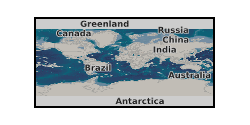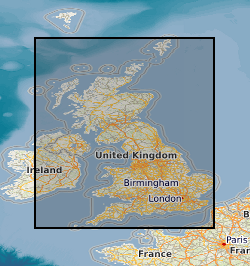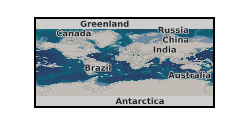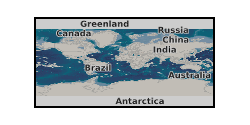pH value
Type of resources
Topics
Keywords
Contact for the resource
Provided by
Years
Formats
Representation types
Update frequencies
Scale
-

Boron isotope and trace metal measurements of fibrous aragonite in modern deep-sea coral Desmophyllum dianthus and associated CDIAC (Carbon Dioxide Information Analysis Center) hydrographic data. Atlantic Ocean, Pacific Ocean, Southern Ocean
-

Water samples have predominantly been collected by the G-BASE (Geochemical Baseline Survey of the Environment) project at an average sampling density of one sample per 1.5 km square. Samples have been collected from approximately 85% of Great Britain but it is only from Wales and Humber-Trent southwards that a wide range of analytes have been determined. Currently G-BASE stream water samples collected from high order streams are determined by ICP-AES for 27 elements - Sr, Cd, Ba, Si, Mn, Fe, P, S (as SO42-), B, Mg, V, Na, Mo, Al, Be, Ca, Zn, Cu, Pb, Li, Zr, Co, Ni, Y, La, K and Cr; and by quadrupole ICP-MS for 24 trace elements - Li, Be, Al, V, Cr, Co, Ni, Cu, As, Rb, Y, Zr, Mo, Ag, Cd, Sn, Sb, Ba, La, Ce, Tl, Pb, Th and U. Automated colorimetric methods are used to determine Cl and NO3- and ion selective electrode is used to determine F. Waters are also analysed for non-purgeable organic carbon (NPOC) to determine dissolved organic carbon content. All samples have routinely been analysed for pH, conductivity and bicarbonate. Much of the UK coverage also includes uranium and fluoride analyses.
-

This study explored the links between host rock composition, hydrothermal fluid composition (particularly pH), and the resulting ore minerals and deposits. The progressive water–rock reaction between 1 kg of initially acidic, condensed magmatic vapour and a series of different rock compositions was modelled with CHILLER (Reed, 1982, Reed, 1998), and follows the design of the water-rock reactions of Reed (1997). The thermodynamic data used in the numerical experiments are from the database SOLTHERM.H08 (Reed and Palandri, 2013). Data and calculations within SOLTHERM include: equilibrium constants calculated with SUPCRT92 (Johnson et al., 1992); mineral thermodynamic data for silicates, oxides, hydroxides, carbonates, gases (Holland and Powell, 1998) and sulphides (Shock, 2007). Mineral solid solutions are represented by end-member compositions that are mixed using an ideal multisite mixing scheme. Rock compositions used in the modelling represent a sub-alkaline andesitic control, and a number of alkaline compositions associated with world-class Au deposits. All starting rock compositions are derived from whole rock geochemical data, and have been recalculated to a 100% basis without TiO2 or P2O5 (excluded as minor phases with little to no effect on hydrothermal mineral assemblages). Original total Fe (as Fe2O3) has been recalculated to FeO and Fe2O3 using the method of Müller et al. (2001). The andesite is representative of calc-alkaline, silica saturated compositions, and is derived from and discussed in detail in Reed (1997). The Luise “Phonolite” (a trachyandesite using the Le Maitre et al., 1989 TAS plot; Fig. 1) and Trachyandesite are from the vicinity of the Ladolam epithermal Au deposit, Lihir Island, Papua New Guinea (Müller et al., 2001). The Porgera Mugearite and Feldspar Porphyry represent unaltered host rock compositions (Richards, 1990) from the Porgera Au deposit (Papua New Guinea). The Cripple Creek Phonolite is part of the host suite to the Cripple Creek epithermal Au deposit, Colorado (Kelley et al., 1998). The Savo trachyte (Smith et al., 2009) represents a typical host rock of the active hydrothermal system (Smith et al., 2010), on Savo island, Solomon Islands. With the exception of the Andesite, all compositions are alkaline using the total alkali versus silica definition of Irvine and Baragar (1971). The Savo sample is not associated with known epithermal Au mineralisation; this composition was selected on the grounds that it represents an evolved (SiO2-rich) silica-saturated, alkaline composition. The initial fluid composition is based on a condensate from Augustine volcano (Symonds et al., 1990) mixed 1:10 with pure water (Reed, 1997; Table 2). A single starting fluid for all models was chosen so as to demonstrate the effect of host rock alone.
-

The dataset contains results of field measurements (temperature, pH, conductivity, redox potential, oxygen content) of groundwater and samples collection details as well as the results of laboratory analysis of the set of dissolved and gaseous parameters performed within the environmental monitoring campaign on 3 Polish shale gas sites where exploration activities including hydraulic fracturing were conducted in 2010-2016 period.
-

Data set is of drill fluid return, settling tank, and bore hole flush fluids sampled during the development of GGC01 seismic monitoring borehole and GGA07 and GGA08 mine water geothermal wells at the UKGEOS - Glasgow site.
-

Global warming during the Palaeocene-Eocene Thermal Maximum (PETM, ~56 Ma) is commonly interpreted as being driven by massive destabilization of carbon from surficial sedimentary reservoirs. If correct, this has important implications for the amplification of future fossil fuel emissions via carbon-climate feedbacks. In our study we provided new paired records of boron and carbon isotope changes in the ocean that questions this long-held interpretation. Our data are implemented in an Earth system model to reconstruct the unfolding carbon cycle dynamics across the event. Strong evidence for a larger (>10,000 PgC) and on average isotopically heavier (> -17‰) carbon source leads us to identify volcanism associated with the North Atlantic Igneous Province as the main driver of the PETM. We also find that although organic carbon feedbacks with climate played a more minor role in driving the event than previously thought, organic matter burial was important in ultimately sequestering this carbon and driving the recovery of the system. Data presented in this data set comprise geochemical elemental, as well as boron, carbon and oxygen isotopic data from surface dwelling foraminifera Morozovella Subbotina. Alongside the boron isotopic data we also provide reconstructed surface water pH with corresponding uncertainties for our preferred pH reconstruction.
 BGS Data Catalogue
BGS Data Catalogue